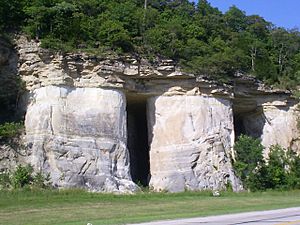St. Peter Sandstone facts for kids
Quick facts for kids St. Peter SandstoneStratigraphic range: Middle Ordovician |
|
|---|---|

Old mine entrances in the St. Peter Sandstone formation in Pacific, Missouri, where it is still actively quarried nearby.
|
|
| Type | Formation |
| Unit of | Ancell Group |
| Underlies | Dutchtown Formation, Glenwood Shale, Joachim Dolomite, and Wells Creek Formation |
| Overlies | Beekmantown Dolomite, Everton Formation, Shakopee Dolomite |
| Location | |
| Region | Midwest |
| Country | United States |
| Extent | Arkansas, Illinois, Indiana, Iowa, Minnesota, Missouri, Wisconsin and West Virginia |
| Type section | |
| Named for | St. Peters River (now Minnesota River), Minnesota |
| Named by | David Dale Owen |
| Paleozoic Stratigraphy of the Upper Midwest, USA Dates are approximate, and deposition occurred at slightly different times in different areas |
|---|
Ordovician
|
The St. Peter Sandstone is a special type of rock found underground. It formed a very long time ago, during a period called the Ordovician time. This rock is a geological formation, which means it's a distinct layer of rock that geologists can identify.
Imagine a huge, shallow sea covering parts of North America millions of years ago. The St. Peter Sandstone started as a big sheet of sand at the bottom of this ancient sea. The sand grains are very tiny, round, and made of quartz. They look a bit like frosted glass!
This sandstone layer stretches across many states in the United States. You can find it from Minnesota in the north all the way to Arkansas in the south. It also goes from Illinois in the east to Nebraska and South Dakota in the west.
The St. Peter Sandstone got its name from the St. Peter River, which is now called the Minnesota River. A scientist named David Dale Owen named it in 1847. The first place where this rock was officially studied is near where the Mississippi River and Minnesota River meet, close to Fort Snelling, Minnesota. In some areas, like eastern Missouri, this sand is super pure, almost 100% silica, which is what glass is made of.
Contents
Where Can You See St. Peter Sandstone?
The St. Peter Sandstone is often hidden underground. But in some places, you can see it right at the surface! These spots are called "outcrops."
In Minnesota, you can see this soft sandstone along the bluffs (cliffs) of the Mississippi River valley. It's usually found under a thin layer of another rock called Glenwood Shale. Above that, there's a much thicker rock layer called Platteville Limestone.
- Minnehaha Falls: In Minneapolis, you can see the St. Peter Sandstone at Minnehaha Falls.
- Saint Paul Bluffs: The bluffs from downtown Saint Paul to Mounds Park also show this sandstone.
- Minneopa Falls: Near Mankato, you can find it at Minneopa Falls.
What Is St. Peter Sandstone Used For?
The St. Peter Sandstone is very useful! Because its sand grains are all about the same size and shape, it's perfect for many different things. In stores, it's often called "Ottawa Sand."
Making Glass and Filters
- Glass Production: Since the sand is so pure (mostly silica), it's excellent for making glass. Glassmakers really need clean sand.
- Filters: It's also used as filter sand to clean water or other liquids.
- Molding Sand: In factories, it's used as molding sand to create shapes for metal casting.
Abrasives and Drilling
- Abrasives: The tough quartz grains make it good for abrasives, which are materials used for grinding or polishing.
- Frac Sand: It's very important in oil and gas drilling. This is called "frac sand." Here's how it works:
- Loose sand is mixed with a liquid.
- This mix is pumped into an oil well under very high pressure.
- The sand grains then wedge into tiny cracks in the rock deep underground.
- This holds the cracks open, allowing more oil and gas to flow out.
Science Experiments
- Laboratory Use: Because all the sand particles are so uniform (the same size and shape), scientists use this sand for many different experiments in their labs.
Where Is St. Peter Sandstone Mined?
The St. Peter Sandstone is mined (dug out of the ground) in several states across the Midwest.
- Arkansas: Guion, Arkansas
- Illinois: Ottawa, Illinois, Sheridan, Illinois, Wedron, Illinois, and Naplate, Illinois
- Minnesota: Kasota, Minnesota and Ottawa Township, Minnesota
- Missouri: Pacific, Festus, Crystal City, Augusta, and Pevely
A big company called Unimin is one of the main producers of this commercial sand. They operate mines in many of these locations.

